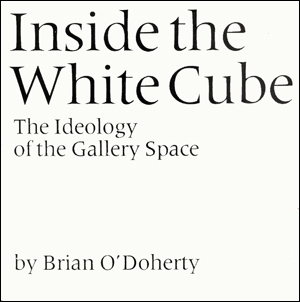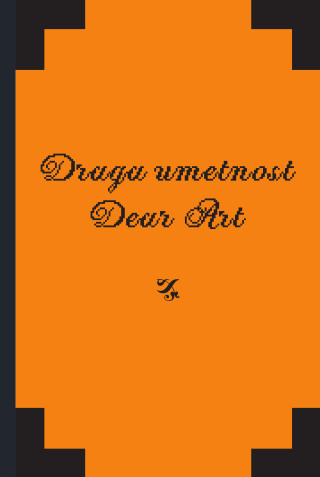Brian O’Doherty: Inside the White Cube: The Ideology of the Gallery Space (1976–) [EN, BR-PT, ES]
Filed under book | Tags: · art, art criticism, art history, art system, exhibition, installation

“When these essays first appeared in Artforum in 1976, their impact was immediate. They were discussed, annotated, cited, collected, and translated–the three issues of Artforum in which they appeared have become nearly impossible to obtain. Having Brian O’Doherty‘s provocative essays available again is a signal event for the art world. This edition also includes “The Gallery as Gesture,” a critically important piece published ten years after the others.
O’Doherty was the first to explicitly confront a particular crisis in postwar art as he sought to examine the assumptions on which the modern commercial and museum gallery was based. Concerned with the complex and sophisticated relationship between economics, social context, and aesthetics as represented in the contested space of the art gallery, he raises the question of how artists must construe their work in relation to the gallery space and system.
These essays are essential reading for anyone interested in the history and issues of postwar art in Europe and the United States. Teeming with ideas, relentless in their pursuit of contradiction and paradox, they exhibit both the understanding of the artist (Patrick Ireland) and the precision of the scholar.”
The essays originally appeared in Artforum magazine, 1976
With an Introduction by Thomas McEvilley
Publisher Lapis Press, San Francisco, 1986
Expanded edition, 1999
ISBN 0520220404
113 pages
Inside the White Cube (English, 1986, 4 MB, added on 2020-3-18)
Inside the White Cube (English, exp.ed., 1999, 6 MB, updated on 2020-3-18)
No interior do cubo branco: a ideologia do espaço da arte (BR-Portuguese, trans. Carlos S. Mendes Rosa, 2002, 158 MB, added on 2016-6-16)
Dentro del cubo blanco (Spanish, trans. Lena Peñate Spicer, 2011, 24 MB, added on 2015-12-30)
What, How and for Whom (eds.): Dear Art (2012)
Filed under booklet, catalogue | Tags: · art, art system, autonomy, contemporary art, institutional critique

“Dear art,” Mladen Stilinović wrote in 1999, “I am writing you a love letter to cheer you up and encourage you to come and visit me some time”. Always acutely aware of his own complicity and involvement, in his address to art Stilinović intimates a set of troubled, poetic, enigmatic and modest observations on the standing of art in the contemporary world, its reception and distribution. But he also questions the value of art, which far too often is translated exclusively in monetary terms, or as he puts it: “quick manipulation, quick money, quick oblivion”.
As in several previous shows curated by What, How and for Whom/WHW, Dear Art takes its title from a work by Mladen Stilinović, and once again its wager is set on the “classical” exhibition format. Amidst the disillusionment created by the persistent feeling of failure (coming from the fact that attempts for a radical reconfiguration of art and cultural production in general always become almost immediately spectacularized), Dear Art insists on the obstinate repetition of what has become the curatorial method. Obsessed with the interconnectedness of art and politics and plagued by the nature of art’s “inefficiency,” it attempts to ask necessary questions: Why do we still need art, and what is it that we expect to get from art today? What is its promise, and what do we promise it in return? And what happens when this promise is broken, betrayed, and just plain exhausted?
“Dear Art” approaches questions of the artist’s autonomy and art’s necessity through works that deliberately blur the relationship between engagement, self-referentiality and aesthetics. Engaged with a range of contradictory, heterogeneous methods that affirm endurance, endure indecisiveness, face misunderstandings and reassert allegiances, the works included address the ways in which misunderstanding, confusion, regret, possession, appreciation and devaluation, support and solidarity play out in contemporary art practice, and in defining one’s practice in relation to discussions on reconfiguring the field of art and its relationship to the political.
The exhibition is accompanied by a publication, with texts by Mladen Stilinović, WHW and Stephen Wright, featuring works by Mounira Al Solh & Bassam Ramlawi, Halil Altindere, Rossella Biscotti, Chto delat?, Every Man is a Curator / Jeder Mensch ist ein Kurator. An archive as a tool, Fokus grupa (Iva Kovač & Elvis Krstulović), Siniša Ilić, Sanja Iveković, Janez Janša, Janez Janša, Janez Janša, Lutz Krüger, Marina Naprushkina, Hila Peleg in collaboration with Tirdad Zolghadr & Anton Vidokle, Cesare Pietroiusti, Public Library (Luka Prinčič, Marcell Mars, Tomislav Medak, Vuk Ćosić), Greg Sholette, Mladen Stilinović, and Wendelien Van Oldenborgh.
Publisher Moderna galerija, Ljubljana, November 2012
56 pages
exhibition (29 November 2012 – 10 February 2013, Museum of Contemporary Art Metelkova, Maistrova 3)
Comment (0)Julian Stallabrass: Contemporary Art: A Very Short Introduction (2006)
Filed under book | Tags: · art, art criticism, art system, contemporary art, neoliberalism, politics, postmodern, production

“Bloody toy soldiers, gilded shopping carts, and embroidered tents. Contemporary art is supposed to be a realm of freedom where artists shock, break taboos, flout generally received ideas, and switch between confronting viewers with works of great emotional profundity and jaw-dropping triviality. But away from shock tactics in the gallery, there are many unanswered questions. Who is really running the art world? What effect has America’s growing political and cultural dominance had on art?
Julian Stallabrass takes us inside the international art world to answer these questions, and to argue that behind contemporary art’s variety and apparent unpredictability lies a grim uniformity. Its mysteries are all too easily explained, its depths much shallower than they seem. Contemporary art seeks to bamboozle its viewers while being the willing slave of business and government.”
Publisher Oxford University Press, 2006
Volume 146 of Very short introductions
ISBN 0192806467, 9780192806468
154 pages
PDF (updated on 2015-5-7)
Comment (0)
